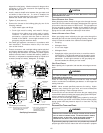
32
motor to reset and recognize new speed selection. Turn on
power to furnace. Verify selected CFM by counting the green
CFM LED blinks.
In general lower heating speeds will: reduce electrical consump-
tion, lower operating sound levels of the blower, and increase the
outlet air temperature delivered to the home. The speeds avail-
able allow the blower performance to be optimized for the particu-
lar homeowner’s needs.
BLOWER HEAT OFF DELAY TIMINGS
The integrated control module provides a selectable heat off delay
function. The heat off delay period may be set to 90, 120, 150, 180
seconds using the DIP switches or jumper provided on the control
module. The delay is factory shipped at 150 seconds but may be
changed to suit the installation requirements and/or homeowner
preference. Refer to the following figures for switch positions and
corresponding delay times.
Heat Off
Delay
90 Seconds
ON
ON 1
2
3
Heat Off
Delay
120 Seconds
Heat Off
Delay
150 Seconds
Heat Off
Delay
180 Seconds
ON
OFF
1
2
3
ON 1
2
3
1
2
3
OFF
OFF
Heat Off Delay
(* indicates factory setting)
*
OFF
Heat Off Delay Switches
XVXV
XVXV
XV
. NO. NO
. NO. NO
. NO
RMRM
RMRM
RM
AL SEQUENAL SEQUEN
AL SEQUENAL SEQUEN
AL SEQUEN
CE OCE O
CE OCE O
CE O
F OPERAF OPERA
F OPERAF OPERA
F OPERA
TITI
TITI
TI
OO
OO
O
NN
NN
N
POWER UP
The normal power up sequence is as follows:
• 115 VAC power applied to furnace.
• Integrated control module performs internal checks.
• Integrated control module flashes LED one time.
• Integrated control module monitors safety circuits
continuously.
• Furnace awaits call from thermostat.
HEATING MODE
The normal operational sequence in heating mode is as follows:
• R and W1 (or R and W1/W2) thermostat contacts close,
initiating a call for heat.
• Integrated control module performs safety circuit checks.
• Induced draft blower is energized on high speed for a 10-
second prepurge. Humidifier terminals are energized with
induced draft blower.
• Induced draft blower steps to low speed following prepurge.
Low stage pressure switch contacts are closed.
• Igniter warm up begins upon step to low speed and
presence of closed low stage pressure switch contacts.
• Gas valve opens at end of igniter warm up period, delivering
gas to burners and establishing flame.
• Integrated control module monitors flame presence. Gas
valve will remain open only if flame is detected.
• If the thermostat call is for low heat, gas valve and induced
draft blower will continue on low stage. If the call is for high
heat, the gas valve and induced draft blower will change to
high stage.
• Circulator blower is energized on heat speed following a
fixed thirty second blower on delay. The circulator blower
requires thirty (30) seconds to ramp up to full speed.
Electronic air cleaner terminals are energized with circulator
blower.
• Furnace is now operating on the specified stage called for
by the two-stage thermostat.
• Furnace runs, integrated control module monitors safety
circuits continuously.
• If the two-stage thermostat changes the call from low heat
to high heat, the integrated control module will immediately
switch the induced draft blower, gas valve, and circulator
blower to their high stage settings.
• If the two-stage thermostat changes the call from high heat
to low heat, the control will immediately switch the induced
draft blower and gas valve to their low stage settings. The
circulator blower will remain on high heating speed for thirty
(30) seconds before switching to the low heat circulating
speed.
• R and W1 (or R and W1/W2) thermostat contacts open,
completing the call for heat.
• Gas valve closes, extinguishing flame.
• Induced draft blower is de-energized following a fifteen
second post purge. Humidifier terminals are de-energized.
• Circulator blower continues running for the selected heat
off delay period (90, 120, 150 or 180 seconds). The speed
run during this period depends on the last heat call provided
by the thermostat.
If the last call for heat was a call for low heat, the air circulator
motor will run on low heat speed for the duration of the heat
off delay period (90, 120, 150 or 180 seconds).
If the last call for heat was a call for high heat, the air
circulating motor will run on the high heating speed for thirty
(30) seconds and then switch to the low heating speed for
the balance of the heat off delay period (60, 90, 120 or 150
seconds).
• Circulator blower and electronic air cleaner terminals are
de-energized.
• Circulator blower ramps down to OFF during the 30 seconds
following the heat off delay period.
• Furnace awaits next call from thermostat.
COOLING MODE
The normal operational sequence in cooling mode is as follows:
• R and YLO/G or Y/G thermostat contacts close, initiating a
call for cool.
• Integrated control module performs safety circuit checks.
• Outdoor fan and compressor are energized to their
appropriate speed.


















